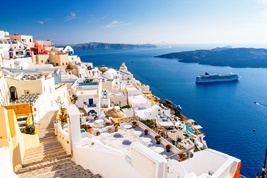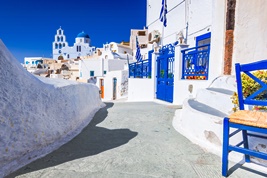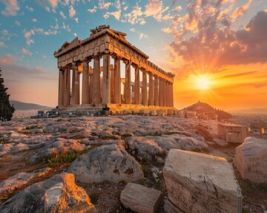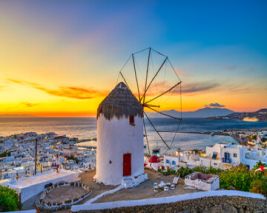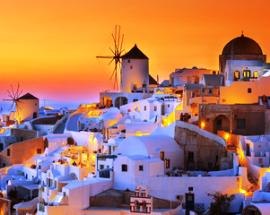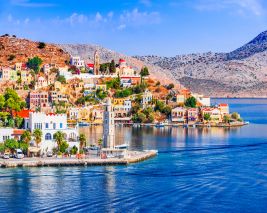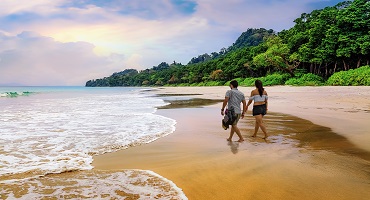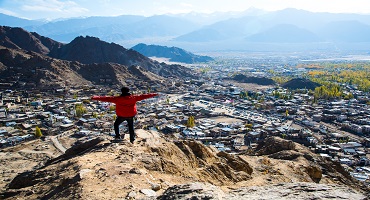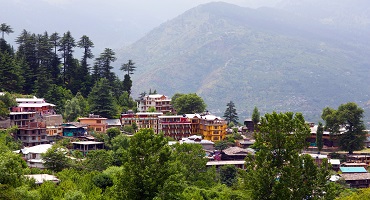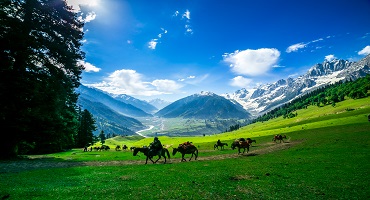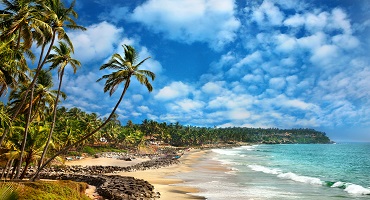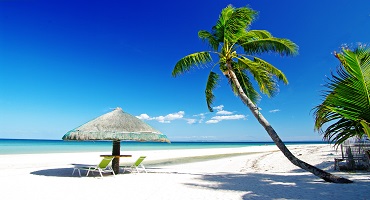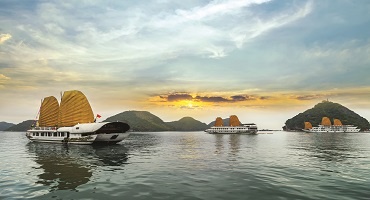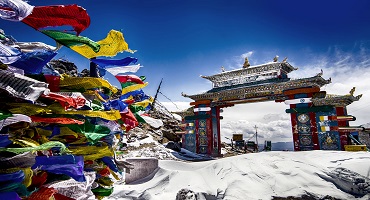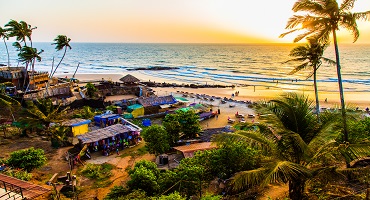Santorini is a gift from the earth - an island formed by the collapse of a volcano that left behind a caldera with this stunning piece of land that’s got everything from colourful beaches to craggy cliffs and divine Mediterranean ocean views — all just a quick flight or panoramic ferry ride away from the city of Athens. Little wonder it is one of Greece’s most visited islands!
As with all destinations, annual seasons play a big part in defining your itinerary. Before booking a tour, it’s vital to know what the weather and activities of Santorini are like, at different times of the year. So, the best time to visit Santorini really depends on the kind of experiences and holiday you wish to have. The conventional peak tourist season is great for those seeking a lively ambience, with the beaches and nightlife at their vibrant best. Families and groups would enjoy the quieter months, with less crowds, low prices and perfect sightseeing weather. In the off-season Santorini is cold and sometimes wet and services are limited. This is when it becomes a haven for honeymooners, photographers, culture enthusiasts and more.
Here’s an in-depth look at Santorini’s seasonal offerings to help you decide when to visit.
Peak Season — Like most of Greece and the Cyclades, Santorini’s peak season is the summer months from June to September. You’ll find the highest frequency of flights and ferries operating during this time. It is when early morning treks are most enjoyed, dips in the sea are most frequent and the nightlife is at its most vibrant. On the other hand, this is when the island is most crowded, and the prices are at their highest.
Shoulder Season — From the end of April till June and from September till the end of October, Santorini experiences its shoulder season when the number of tourists reduce, but the days are still pleasantly warm, the sea waters can still be experienced and most ferry services are running as per usual.
Low Season — November to April, the winter months, are the low season of the island. The cold and rainy weather deters tourists from seeking a beach getaway. However, it is becoming a popular time to visit the island for those who don’t mind the weather and want a quiet escapade with less crowds and activities like sightseeing or hiking.
| Travel Season |
Temperature |
Season |
| Spring |
11 - 22 °C |
Mild, Pleasant |
| Summer |
20 - 30 °C |
Hot, Sunny |
| Fall |
17 - 26 °C |
Mild, Pleasant |
| Winter |
8 - 14 °C |
Cold, Rainy |
Disclaimer — These seasons, temperatures and climatic conditions are estimates and may vary.
Santorini in Spring
Temperature - Between March and May, Santorini experiences the return of warm days with the arrival of a pleasant spring, with average temperatures of 15-18 °C. The days get hotter as summer approaches.
Weather - The sun makes its way past the wet grey winter, bringing back sunny days and a blooming countryside, with stable wind and temperature conditions throughout. Despite being a shoulder season for tourism, Santorini sees plenty of spring-time visitors flock its shores.
Significance - The Island fully awakens after its off-season, with hotels and restaurants beginning to open, the sea water warming up for swims and weather that makes you want to stay outdoors. Still, travellers who make it for early spring can catch some of the best rates to arrive and stay in Santorini. Things truly kick off in April, with the arrival of Easter celebrations — the season’s biggest event.
Things to know before the visit - Hiking, sightseeing, winery visits, sampling authentic Cycladic cuisine — these are some of the top activities of touring Santorini in the spring. Since peak tourism is yet to hit, this is a great time to find attractive travel and accommodation deals. And if you’re lucky, you’ll get to put your swimsuit to use more than a few times.
Tips - Springtime visits to Santorini require you to be prepared for slight weather unpredictability. There’s only the slightest chance of rain — but there is one. Days can get really hot or stay cloudy and cool. So, you’ll need to pack an umbrella, beach wear as well as a warm pullover. Remember to keep your phones and cameras charged during the day - every sunset is worth capturing.
Santorini in Summer
Temperature - Santorini summers are hot and dry, with day temperatures often as high as 30°C. They drop in the early mornings and post sunset, to around 22-24°C.
Weather - The sun shines brightly overhead, the waters glistening invitingly, the wind is mild, and the air is clean — Santorini experiences perfect beach weather in this season.
Significance - This is peak tourist season for more than one reason. It’s the best time to swim the seas or sunbathe by day and sky gaze or barhop by night. It’s also when the island’s cultural calendar is most packed, with the Santorini Jazz Fest in July, Megaron Gyazi and Greek Volcano Festivals in August. These events offer a glimpse into the long-standing traditions of the land with plenty of dancing, music and entertainment to enjoy.
Things to know before the visit - It doesn’t take long for flights and hotels to sell out in the summer, so if you intend on braving the crowds, it’s best to make your bookings months in advance. The good news is that this is also the season with the highest frequency of flights and ferries to Santorini, and every tourist establishment on the island is open at maximum capacity.
Tips - To really enjoy the beach and waters, you must wear protective sunscreen throughout. This is essential even for land activities like hiking or sightseeing. Other important things to pack include a hat, sunglasses, comfortable walking shoes and a universal power adapter for your electronics.
Santorini in Fall
Temperature - Autumn temperatures are similar to those of the spring, with days usually averaging 20-23°C. The cool morning and evening breeze and disappearance of the sun sees this drop into the high teens, but never uncomfortably cold.
Weather - Days are pleasant and the despite being bright, the harshness of the summer sun subsides. A slight increase in wind and precipitation are other typical features of fall weather in Santorini.
Significance - As the rush of summer subsides, the island remains a playground for travel enthusiasts who enjoy land activities. The water stays warm till the end of the season, so early fall visitors can still enjoy a swim or two. It is the best season to explore Santorini without big crowds — perfect for activities like sightseeing, a couple’s retreat, early morning hikes and quiet sunsets.
Things to know before the visit - The only minor downside to planning an autumn visit to Santorini is that many of the island’s establishments such as hotels, restaurants and beach shacks close operations for the off-season. Although nowadays, there are plenty of alternatives that run through the year. There is also an international music festival usually held towards the end of September that’s worth checking out.
Tips - Even though this is pre-winter season, you could chance upon a cold day during your stay so it’s advisable to carry at least one warm jacket or layer. Start your day early, especially if sightseeing, as visiting times at certain attractions may be shorter than usual.
Santorini in Winter
Temperature - Days never get hotter than 15°C, but they can drop as low as 7°C. Early mornings, evenings and nights are the coldest.
Weather - Cool, cloudy and rainy is how you would conventionally describe winters in Santorini, although clear skies and sunshine days offer regular respite.
Significance - Winter isn’t for everyone, especially not a rainy one. But if you don’t mind as much grey sky as sun, then it’s the right time to visit Santorini. Being off-season, you can surely avail the best deals across your stay and there’s no over-crowding at any landmark, be it a museum or a sunset vantage point. During these months, Santorini also observes traditional feasts like the days of Agios Ioannis and Agios Eleftherios, worthy cultural experiences if you’re in town.
Things to know before the visit - Flights and ferries have a limited schedule during the off-seasonal winter months, although daily connectivity from Athens remains. Planning your itinerary and transfers in advance helps smoothen your travel experience.
Tips - Base yourself in one of the main towns of Fira and Oia, which have plenty of functioning tourist services through the winter. Even though you’re on an island, this is the season for which you’ll need to pack winter clothes and an umbrella too.
Now that you’ve heard all about the year in Santorini, it’s time to decide on the perfect dates for your dream island holiday. For that’s all you need to book yourself a fabulous tour of the island, only with Thomas Cook.




